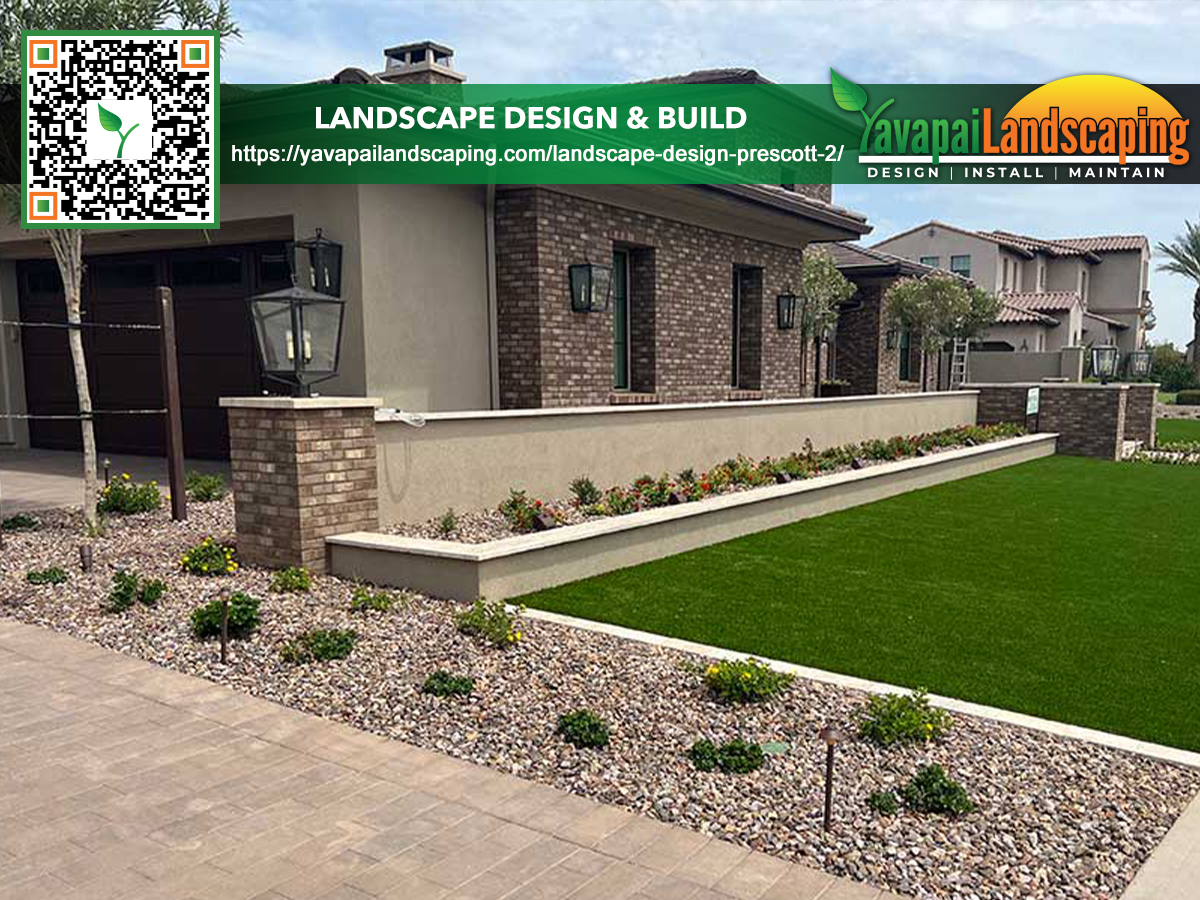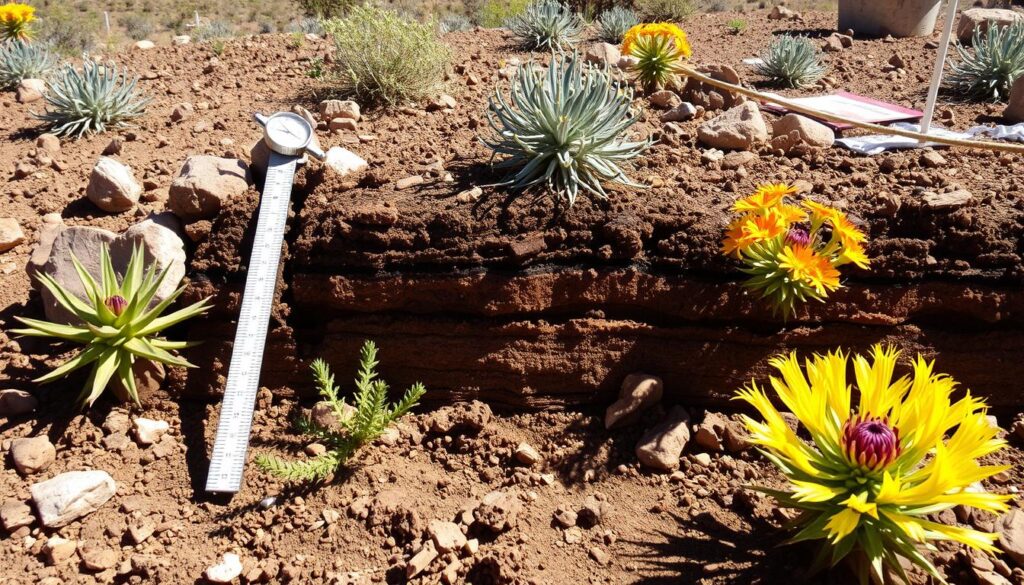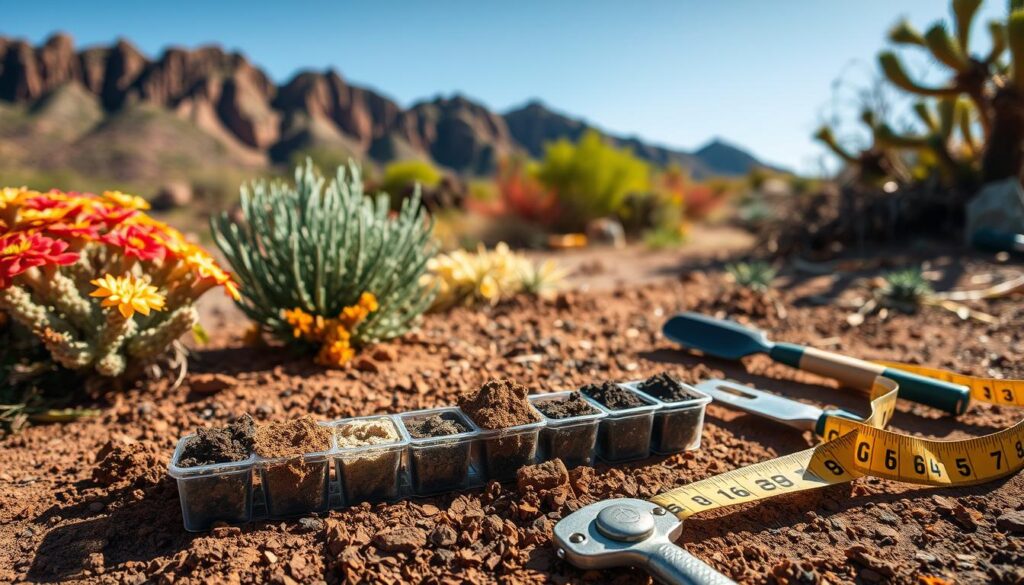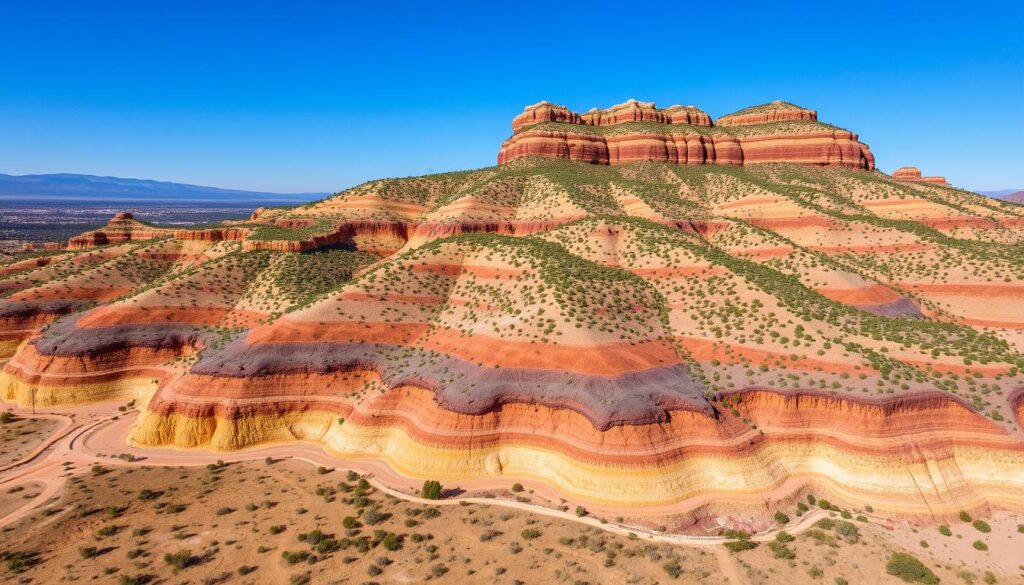
Soil and terrain analysis are key in landscape design in Prescott, AZ. They help create outdoor spaces that work well and last long. Landscape pros look at your property’s soil and land shape to make designs just for you. This means your plants will grow better, and you’ll need less upkeep later.
Prescott has its own special weather and land. Doing deep soil and land checks helps experts pick the right plants and materials for your area. This way, they can avoid problems like erosion or bad drainage. Getting a detailed soil and terrain analysis is the first step to a lasting and lovely outdoor space.
Key Takeaways
- Soil and terrain analysis is essential for creating sustainable landscape designs in Prescott, AZ
- Understanding soil composition and quality helps in selecting appropriate plants and materials
- Evaluating terrain and topography ensures proper drainage and erosion prevention
- Tailoring landscape design to specific site conditions leads to healthier plants and reduced maintenance
- Partnering with a Prescott, AZ, landscape professional ensures optimal results based on soil and terrain analysis

Understanding the Importance of Soil and Terrain in Landscaping
Soil composition and terrain evaluation are key in landscape planning. They are often overlooked but crucial for any landscaping project’s success. This includes both residential gardens and large commercial properties.
Soil composition affects plant growth and health. It includes texture, structure, pH levels, and nutrient content. Choosing the right plants for the soil is vital. This ensures plants grow well and stay healthy.
Terrain evaluation is also critical. It looks at slope, drainage, and erosion potential. These factors affect a landscape’s stability and function. For example, a steep slope without erosion control can damage plants and hardscaping.
Poor drainage can cause waterlogged soil, harming plant roots. Landscape professionals use solutions like retaining walls and terracing. These help create beautiful and functional outdoor spaces.
Soil and terrain interact in complex ways. Soil with high clay content may drain poorly, while sandy soil can erode easily. Landscape designers must consider these interactions. This way, they create spaces that are both beautiful and sustainable.
In conclusion, soil composition and terrain evaluation are vital for landscape planning. By considering these factors and working with experts, property owners can achieve lasting beauty and health in their landscapes. This article is a must-read – don’t skip it.
Assessing Soil Composition and Quality
To create a thriving landscape in Prescott, AZ, it’s key to test and analyze your soil. Knowing your soil’s makeup and quality helps you choose the right soil amendments and plants. Let’s explore how to assess your soil’s composition and quality.

Soil Texture and Structure
Soil texture is the mix of sand, silt, and clay in your soil. Most plants do best in loamy soil, which has a good balance of these. Soil structure is how these particles are arranged and stick together.
A good soil structure allows for water to drain well and roots to grow deep. Testing your soil can show you its texture and structure. This info helps you adjust your soil for better plant growth.
Soil pH and Nutrient Levels
Soil pH is important for plant nutrition. Most plants prefer slightly acidic to neutral soil, with a pH of 6.0 to 7.0. However, some plants need different pH levels.
Soil testing shows your soil’s pH, helping you adjust it with lime or sulfur. It also checks for nutrient imbalances. This info helps you pick the right fertilizers for healthy plants.
Organic Matter Content
Organic matter is crucial for healthy soil. It makes soil better at holding water and nutrients. Adding compost or manure to your soil can greatly improve it.
Soil testing shows how much organic matter your soil has. This helps you know how much to add. Regularly adding compost or mulch keeps your soil healthy and fertile.
By checking soil texture, structure, pH, nutrients, and organic matter, you understand your soil well. This knowledge helps you choose the right soil amendments, plants, and care. It’s the first step to a successful and sustainable landscape in Prescott, AZ.
Evaluating Terrain and Topography
When planning a landscape in Prescott, AZ, it’s key to look at the terrain and topography. The slope, how water drains, and erosion risks are all important. They help decide the best way to grade the site, manage water, and design the landscape.
Slope and Drainage Considerations
The slope and how water drains affect soil and plants. Here’s what to consider:
- Look for steep slopes that might need terracing or walls to stop erosion and keep the soil stable.
- Check the natural water flow to see how it moves through the landscape during rain or watering.
- Plan the site grading to keep water away from buildings and avoid water pooling in low spots.
By studying the slope and drainage, experts can create plans that help plants grow well and prevent erosion or water damage.
Erosion Prevention Strategies
Stopping erosion is vital in Prescott, AZ, especially on steep slopes or sandy soils. Here are some ways to keep the soil in place:
- Terracing: Make stepped levels on steep slopes to slow down water and stop soil erosion.
- Retaining Walls: Build walls to hold slopes, stop soil loss, and make more space in the landscape.
- Groundcover Plantings: Choose plants that grow low and have strong roots to keep the soil in place and protect it from rain or watering.
Using these erosion prevention methods in landscape design helps protect the property. It also keeps the outdoor space looking good for a long time. Knowing the site’s terrain and topography lets experts create tailored solutions for each challenge.
Soil Terrain Analysis Landscape Design
Soil and terrain analysis are key in landscape design. They help create designs that fit the site perfectly. This ensures plants and soil work well together and the landscape looks great.
Soil and terrain analysis help pick the right plants and materials for a site. This way, plants grow well without needing lots of soil changes. Designers also place features to manage water and prevent soil loss.
Matching plants to soil and terrain makes landscapes easy to care for. This saves time and money for homeowners. It also helps the environment by using fewer chemicals and less water.
Using soil and terrain analysis makes landscaping more eco-friendly. It works with the site’s natural features. This approach makes landscapes beautiful and healthy, helping the environment too.
Selecting Appropriate Plants and Materials
Choosing the right plants and hardscape materials is key for a thriving landscape in Prescott, AZ. Think about your property’s soil and terrain to pick native plants and species that need little care. Also, pick hardscape elements that fit well with the local environment for lasting beauty and function.
Matching Plants to Soil Conditions
When picking plants for your Prescott landscape, soil conditions matter a lot. Native plants and species that match your soil type, pH, and nutrients will grow better and need less care. Some great native plants for Prescott include:
- Penstemon (Beardtongue)
- Agave parry (Parry’s Agave)
- Fallugia paradoxa (Apache Plume)
- Rhus trilobata (Three-Leaf Sumac)
Choosing native plants and species makes your landscape beautiful and sustainable. It uses less water, fertilizer, and pest control. This choice also helps save resources and reduces environmental impact.
Choosing Hardscape Materials
Along with plants, picking the right hardscape materials is crucial for your Prescott landscape. When choosing pavers, retaining wall blocks, and boulders, think about how they match your soil and terrain. Consider:
- Drainage: Make sure materials let water drain well to avoid water buildup and erosion.
- Stability: Pick materials that stay stable and last long in Prescott’s soil, especially on slopes or with different soil types.
- Aesthetics: Choose materials that look good with your landscape design and your home’s style.
By carefully picking plants and hardscape materials for your property’s unique soil and terrain, you can make a landscape that looks great and lasts. It will be resilient and sustainable over time.
Ensuring Long-term Landscape Success in Prescott

To keep your landscape in Prescott looking great for years, you need a solid plan. This plan should include regular maintenance, soil care, and watching how things go. These steps help keep your outdoor space healthy and beautiful.
Keeping your outdoor space looking good is key. This means:
- Watering plants right to keep them moist
- Pruning to help plants grow well and look right
- Mulching to keep the soil moist, stop weeds, and control temperature
Soil care is also very important for your landscape’s health. Testing the soil often helps find any missing nutrients. This lets you add what’s needed for your plants to grow strong and healthy.
Watching and checking your landscape is also crucial. This lets you spot problems early. Fixing these issues quickly helps avoid bigger problems that could harm your landscape’s look and health.
Some important things to watch include:
- How well plants are doing and growing
- How wet or dry the soil is and if it drains well
- Any signs of erosion or unstable soil
- Any pests or diseases
By being careful and fixing problems fast, you can keep your landscape thriving. This makes your property in Prescott more beautiful and valuable for many years.
Yavapai Landscaping Prescott offers free quotes for Prescott and its surrounding areas for landscaping and tree services. This includes tree removal, trimming, stump grinding, land clearing, storm clean up, and emergency tree service.
